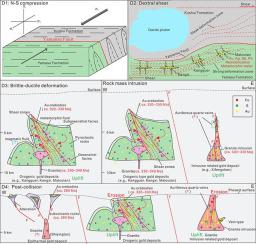Ore Geology Reviews ( IF 3.2 ) Pub Date : 2022-08-28 , DOI: 10.1016/j.oregeorev.2022.105080 Biao Liu , Ping-He Sun , Qian-Hong Wu , Jiang-Bo Jiang , Huan Li , Jeff Dick , Hua Kong , Xiao-Shuang Xi , Han Zheng , Guo-Xiong Cao , Yu-Ting Meng

|
The Kanggur, Kangxi and Matoutan deposits are three important orogenic gold deposits located in the Kanggurtag gold mineralization belt of Eastern Tianshan, NW China. These deposits are hosted in low-grade metamorphic (greenschist-facies) volcaniclastic rocks of the Early Carboniferous Yamansu Formation. The orebodies are distributed in approximately E–W-striking shear zones and show evidence of hydrothermal alteration and four deformation events. The first deformation (D1) is associated with progressive regional N–S shortening without growth of gold mineralization. The second deformation (D2) is manifested by right-lateral shear zones under ductile conditions, which triggered the initial enrichment of gold in the stage I pyrite. The third deformation (D3) is characterized by a transpressional event under ductile–brittle conditions and formed stage II–Ⅳ pyrites with dominant Au mineralization; the native gold is mainly distributed in the interstices or interface of the pyrites. The fourth deformation (D4) is archived by post-collision extensional structures accompanied by magma emplacement and numerous limonite and comb-like quartz veins.
Six pyrite samples (stage III) separated from the Kanggur deposit yield a Re–Os isochron age of 321 ± 6.7 Ma (MSWD = 3.0, initial 187Os/188Os = 0.35 ± 0.22). Three pyrite samples (stage III) separated from the Kangxi deposit yield a Re–Os isochron age of 327 ± 4.5 Ma (MSWD = 1.2, initial 187Os/188Os = 0.94 ± 0.12). The δ34S value significantly increases from stage I pyrite (−37.3‰ to −25.5‰, average = −32.2‰) to stage II−Ⅳ pyrite (−0.90‰ to 6.30‰, average = 1.96‰), indicating that sulfur in stage I pyrite migrated from sedimentary sources whereas in stage II–Ⅳ pyrites it was derived from the pyroclastic rocks in the country rocks. The H–O isotopic compositions of quartz show that the fluid in stage I (δ18Ow = 2.25‰ to 5.15‰, δ2D = −66.0‰ to −42.5‰) was metamorphic water and the fluid in stage Ⅴ was mixed with a large proportion of meteoric water. The fluids in stages II–Ⅳ maybe a “second hand” magmatic origin related to the andesite in the country rocks. Therefore, we propose that Au mineralization in the Kanggur, Kangxi and Matoutan deposits derived mainly from a metamorphic fluid source associated with the pyroclastic rocks in the country rocks. In addition, we conclude that these deposits are orogenic gold deposits that formed during the Late Carboniferous collisional tectonism (ca. 320 Ma) and the epithermal Au deposits (ca. 280 Ma) maybe associated with the post-collision extensional setting.











































 京公网安备 11010802027423号
京公网安备 11010802027423号